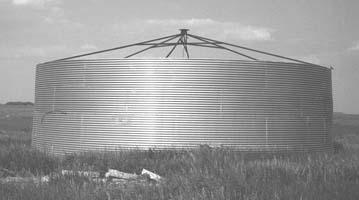
The combination of a bumper corn crop and low corn prices prompted Jim Noram, Currie, Minn., to build his own temporary grain bin that has no permanent roof or floor and cost thousands of dollars less than a permanent conventional bin.
"I didn't want to pay our local grain elevator to store my corn," says Noram.
The bin measures 36 ft. in diameter and 12 ft. high and holds 10,000 to 13,000 bu. The roof is simply a layer of plastic stretched tight over a peaked steel frame, while the floor consists of a layer of plastic on top of a gravel and clay base. The sides consist of four 3-ft. high rings of corrugated steel bolted together.
Noram laid down a 6-in. deep layer of gravel on top of a 2-ft. layer of clay, then staked a layer of heavy-duty plastic down over it. After bolting the four rings together, he used 1 by 2-in. steel tubing to build a frame for the roof and bolted it to the top ring. To provide aeration, he places a length of 12-in. dia. tile on top of the plastic in a circle that's about 6 in. from the bin sides. A section of tile runs to the center of the bin where it makes a 90 degree bend and goes vertically up to the top of the bin. An 18-in. dia. electric fan blows air down through the tile.
Noram dries corn down to 15 percent moisture in a nearby bin, then transfers it by auger onto a "splash cone" at the top of the temporary bin. Once the bin is full he puts a big sheet of plastic over the top and uses a nylon rope to pull it down tight onto the frame. The rope is woven through eye-lets along the edge of the plastic. After pulling the plastic tight against the roof frame, Noram ties the bottom end of the rope to a series of I-bolts spaced at intervals around the the bin wall. Noram places several short lengths of 6-in. dia. tile on top of the corn to keep the plastic from sagging down against it and causing condensation.
"It lets me safely store corn for up to six months in the winter. It paid for itself the first year," says Noram. "I bought the rings at a sale. I paid for two sections of plastic which I had a company sew together. I check the condition of the corn on a regular basis. I use duct tape to patch up holes in the plastic. One year I had some spoilage caused by a pin hole. The aeration system works good -- the fan has enough air pressure so when it's on the plastic billows up. I use an auger at the bottom of the bin to unload and insert a grain vac through a door to suck out leftover corn.
"It works better than commercial plastic temporary bins because they're guaranteed for only two years and have to be collapsed for storage when they're not being used. My bin doesn't have to be taken down so it has better resale value. And it has the potential to be expanded into a much bigger bin. Someday I plan to finish it off and increase the storage capacity to 20,000 bu."
